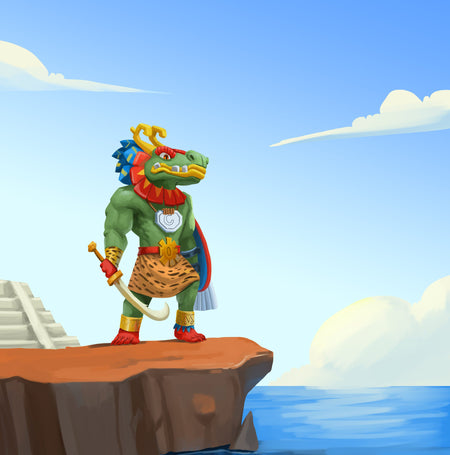Direct Link of story: https://www.army.mil/asianpacificamericans/history/ The U.S. Army's Philippine Scouts
 These were Gen. Douglas MacArthur's Soldiers, who fought America's first battle of World War II - the Philippine Division - probably the best trained and possibly the best prepared U.S. Army division at the outset of the war. Some of them were farm boys from California and Kansas, and Italian-Americans from New Jersey, as depicted in the black and white movies made during and after World War II. However, many of them were professional Filipino soldiers serving in the U.S. Army, commanded by American officers. They were special men in special units, officially designated Philippine scouts, a term applied both to the Filipino enlisted men and to their American officers. For a young Filipino man, acceptance into the Philippine scouts was a distinct honor - as was service in the scout units for American officers. The Imperial Japanese Navy attacked Pearl Harbor, Dec. 7, 1941, but Pearl Harbor was only part of a much bigger Japanese operation that day. On Dec. 7, the Japanese not only sank the U.S. Navy's Pacific fleet at Pearl Harbor, they also bombed the U.S. Army's B-17 bomber base at Clark Field in the Philippines, attacked British Hong Kong, and landed troops on the shores of British Malaya. The four attacks were coordinated to begin at the same moment, but because of weather problems, the U.S. Navy's battleships were already sinking to the bottom of Pearl Harbor by the time Japanese bombers destroyed the American fighters and bombers on the ground at Clark Field.
These were Gen. Douglas MacArthur's Soldiers, who fought America's first battle of World War II - the Philippine Division - probably the best trained and possibly the best prepared U.S. Army division at the outset of the war. Some of them were farm boys from California and Kansas, and Italian-Americans from New Jersey, as depicted in the black and white movies made during and after World War II. However, many of them were professional Filipino soldiers serving in the U.S. Army, commanded by American officers. They were special men in special units, officially designated Philippine scouts, a term applied both to the Filipino enlisted men and to their American officers. For a young Filipino man, acceptance into the Philippine scouts was a distinct honor - as was service in the scout units for American officers. The Imperial Japanese Navy attacked Pearl Harbor, Dec. 7, 1941, but Pearl Harbor was only part of a much bigger Japanese operation that day. On Dec. 7, the Japanese not only sank the U.S. Navy's Pacific fleet at Pearl Harbor, they also bombed the U.S. Army's B-17 bomber base at Clark Field in the Philippines, attacked British Hong Kong, and landed troops on the shores of British Malaya. The four attacks were coordinated to begin at the same moment, but because of weather problems, the U.S. Navy's battleships were already sinking to the bottom of Pearl Harbor by the time Japanese bombers destroyed the American fighters and bombers on the ground at Clark Field.  The Japanese invasion of the Philippines was the first action of World War II in which units of the U.S. Army faced the enemy on the ground. MacArthur had his entire Army withdraw to the Bataan Peninsula and to Corregidor Island to hold off the enemy until the U.S. Navy could bring reinforcements and supplies. The Philippine Scouts, side-by-side with U.S. National Guard and Philippine army infantry units, defeated the Japanese army in numerous actions in the interior and on the coastlines of Bataan. Survivors of the Battle of Bataan, to a man, describe the Philippine scouts as the backbone of the American defense there. President Franklin Roosevelt awarded the U.S. Army's first three Congressional Medals of Honor of World War II to Philippine scouts: Sgt. Jose Calugas for action at Culis, Bataan on Jan. 6, 1942; Lt. Alexander Nininger for action near Abucay, Bataan on Jan. 12; and Lt. Willibald Bianchi for action near Bagac, Bataan on Feb. 3, 1942. By March 1942, the Japanese army had marched through Southeast Asia and completely overrun every country and island in the western Pacific with the exception of the Philippines. The Philippines, and MacArthur's army, were alone. On the Bataan peninsula of Luzon Island, the Philippine scouts, a few U.S. Army National Guard units, and 10 divisions of poorly equipped, almost untrained Philippine army soldiers held out for four months against the Japanese. With the U.S. Navy at Pearl Harbor in shambles, and the Japanese navy blockading the Philippines, there was no way for America to get reinforcements, food or medicine to the troops on Bataan. Nonetheless, they held out while malaria, dysentery and malnutrition ravaged their ranks, and Japanese attacks drove them further down the Bataan peninsula. Fresh Japanese troops began a crushing attack on the U.S. forces on Bataan, April 3, 1942. Although the men fought bravely, the Battle of Bataan ended, April 9, 1942, when Gen. Edward King surrendered rather than see any more of his starving, diseased men slaughtered by the advancing Japanese army. At that point, 75,000 men became prisoners of war - about 12,000 Americans and 63,000 Filipinos. What followed was one of the worst atrocities in modern wartime history - the Bataan Death March. In the Philippines, a strong guerrilla movement developed to fight Japanese oppression. Philippine scout officers and enlisted men, who had escaped from the Japanese, and others who chose to ignore their parole terms, joined these clandestine groups to do what they could to hasten the return of U.S. forces. Contrary to the impression many of us get from our history textbooks, help was not on the way. MacArthur had his forces, such as they were, engaged around the Solomon Islands and New Guinea to protect Australia from Japanese attack. It was not until 1944 that MacArthur, in the south, and Admiral Nimitz, to the east, commenced their two-pronged advance into the Pacific. But during the interim years, the Philippine guerrillas put together a close network to gather intelligence data on Japanese troop movements and shipping, and transmit it to MacArthur's headquarters using radios smuggled in by submarine. It has been said that their information was so complete, that when MacArthur finally did make it back to the Philippines, he knew what every Japanese lieutenant ate for breakfast and where he had his hair cut. As MacArthur's forces, supported by the guerrillas, rolled into the Philippine Islands, men began to come out of hiding. The Philippine scouts, some who were members of the guerrilla forces, some who were not, stepped forward and rejoined the U.S. Army. Other Filipino guerrillas joined them and the Army set up new Philippine scout units. The new scouts actively participated in combat against the Japanese army in north Luzon, and served as military police to restore order and help locate pockets of escaped Japanese in the south. As planning for the invasion of Japan progressed, the Philippine scouts were included in the invasion forces and began training for what was expected to be the bloodiest struggle of World War II.
The Japanese invasion of the Philippines was the first action of World War II in which units of the U.S. Army faced the enemy on the ground. MacArthur had his entire Army withdraw to the Bataan Peninsula and to Corregidor Island to hold off the enemy until the U.S. Navy could bring reinforcements and supplies. The Philippine Scouts, side-by-side with U.S. National Guard and Philippine army infantry units, defeated the Japanese army in numerous actions in the interior and on the coastlines of Bataan. Survivors of the Battle of Bataan, to a man, describe the Philippine scouts as the backbone of the American defense there. President Franklin Roosevelt awarded the U.S. Army's first three Congressional Medals of Honor of World War II to Philippine scouts: Sgt. Jose Calugas for action at Culis, Bataan on Jan. 6, 1942; Lt. Alexander Nininger for action near Abucay, Bataan on Jan. 12; and Lt. Willibald Bianchi for action near Bagac, Bataan on Feb. 3, 1942. By March 1942, the Japanese army had marched through Southeast Asia and completely overrun every country and island in the western Pacific with the exception of the Philippines. The Philippines, and MacArthur's army, were alone. On the Bataan peninsula of Luzon Island, the Philippine scouts, a few U.S. Army National Guard units, and 10 divisions of poorly equipped, almost untrained Philippine army soldiers held out for four months against the Japanese. With the U.S. Navy at Pearl Harbor in shambles, and the Japanese navy blockading the Philippines, there was no way for America to get reinforcements, food or medicine to the troops on Bataan. Nonetheless, they held out while malaria, dysentery and malnutrition ravaged their ranks, and Japanese attacks drove them further down the Bataan peninsula. Fresh Japanese troops began a crushing attack on the U.S. forces on Bataan, April 3, 1942. Although the men fought bravely, the Battle of Bataan ended, April 9, 1942, when Gen. Edward King surrendered rather than see any more of his starving, diseased men slaughtered by the advancing Japanese army. At that point, 75,000 men became prisoners of war - about 12,000 Americans and 63,000 Filipinos. What followed was one of the worst atrocities in modern wartime history - the Bataan Death March. In the Philippines, a strong guerrilla movement developed to fight Japanese oppression. Philippine scout officers and enlisted men, who had escaped from the Japanese, and others who chose to ignore their parole terms, joined these clandestine groups to do what they could to hasten the return of U.S. forces. Contrary to the impression many of us get from our history textbooks, help was not on the way. MacArthur had his forces, such as they were, engaged around the Solomon Islands and New Guinea to protect Australia from Japanese attack. It was not until 1944 that MacArthur, in the south, and Admiral Nimitz, to the east, commenced their two-pronged advance into the Pacific. But during the interim years, the Philippine guerrillas put together a close network to gather intelligence data on Japanese troop movements and shipping, and transmit it to MacArthur's headquarters using radios smuggled in by submarine. It has been said that their information was so complete, that when MacArthur finally did make it back to the Philippines, he knew what every Japanese lieutenant ate for breakfast and where he had his hair cut. As MacArthur's forces, supported by the guerrillas, rolled into the Philippine Islands, men began to come out of hiding. The Philippine scouts, some who were members of the guerrilla forces, some who were not, stepped forward and rejoined the U.S. Army. Other Filipino guerrillas joined them and the Army set up new Philippine scout units. The new scouts actively participated in combat against the Japanese army in north Luzon, and served as military police to restore order and help locate pockets of escaped Japanese in the south. As planning for the invasion of Japan progressed, the Philippine scouts were included in the invasion forces and began training for what was expected to be the bloodiest struggle of World War II.




